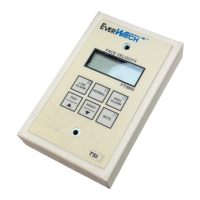User Basics
Part One
User Basics
This section provides a brief but thorough overview of the EverWatch product by
maximizing information with minimal reading. These few pages explain the purpose (The
Instrument), and the operation (Useful user information, Operator panel, Alarms) of the
product. Technical product information is available in Part Two of the manual.
The Instrument
The EverWatch monitor measures and reports “face velocity” in fume hoods. Adequate
face velocity is a key component needed to protect fume hood users. An adequate face
velocity contains all the contaminants inside of the fume hood.
The fume hood exhaust system produces a pressure differential between the hood
interior and the laboratory, causing air to be drawn into the hood. In a properly designed
and used fume hood the air drawn into the fume hood is the same everywhere in the
sash plane (opening). The speed the air enters the fume hood is called the face velocity.
The Model 8610 EverWatch Face Velocity Monitor continuously monitors fume hood face
velocity by measuring the air velocity across a sensor mounted in the sidewall of the
hood. The sensor and opening in the fume hood are driven by the same pressure
differential so the velocity across each is related.
The EverWatch device informs the hood user when the fume hood has an adequate face
velocity by indicating the actual face velocity and turning on a green light. If the face
velocity is inadequate, or too great, a red alarm light and audible alarm turn on.
The EverWatch monitor consists of two pieces; a velocity sensor and monitor electronics.
The velocity sensor is mounted in the sidewall of the fume hood usually near the top of
the sash. The monitor electronics are typically mounted about eye level on the front of
the fume hood cabinetry. The velocity sensor continuously measures the face velocity
and provides the face velocity information to the monitor electronics. The monitor
electronics continuously report the face velocity and activates the alarms when
necessary.
Useful User Information
The monitor electronics has a green light (normal operation) and red alarm light (low and
high alarms). The green light is on when the face velocity is adequate. The red low alarm
light comes on when the face velocity drops below a safe level. The red high alarm light
comes on when the face velocity exceeds a safe level. The display provides additional
information by continuously indicating the actual face velocity

